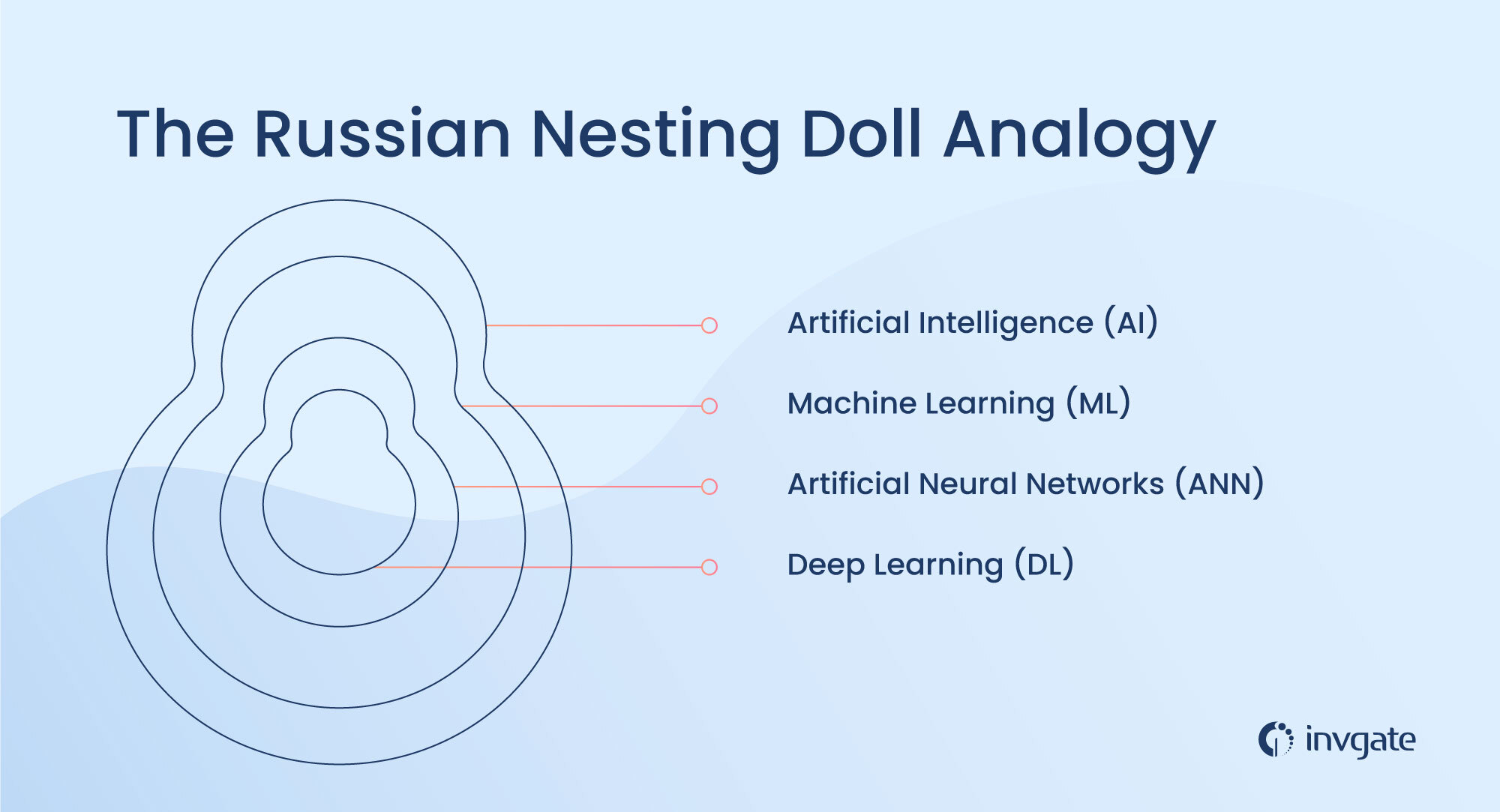The ongoing debate surrounding artificial intelligence (AI) has caused a great deal of confusion. There are numerous terms associated with AI that may seem similar at first glance, but upon closer inspection, their distinctions become apparent. In this article, we aim to differentiate between AI, machine learning, deep learning, and neural networks to provide clarity on these concepts.
In essence, we will explore the relationships among these concepts and highlight their unique characteristics. We will also delve into the role of AI within each of these domains. So, without further delay, let’s delve into the world of AI and its diverse applications.
AI vs. Machine Learning vs. Deep Learning vs. Neural Networks: Understanding the Differences
To comprehend the relationships among artificial intelligence, machine learning, neural networks, and deep learning, we can employ the analogy of Russian nesting dolls, where each concept is a component of the preceding one.

In simple terms, machine learning is a subset of artificial intelligence, neural networks are a subset of machine learning, and deep learning algorithms represent an evolution of neural networks.
The distinction between neural networks and deep learning lies in the latter’s more intricate nature, with deep learning being a more complex iteration of neural networks.
Let’s explore some key differences to gain a deeper understanding of how these AI components function.
Exploring the Differences Between Deep Learning and Neural Networks
When discussing neural networks and deep learning, it’s important to note that these concepts are closely intertwined. Deep learning refers to the depth of layers and nodes within a neural network. Therefore, a neural network with more than three layers (including input and output) is classified as a deep learning algorithm.
Furthermore, most deep neural networks operate in a feed-forward manner, progressing solely from input to output. These models can be trained through backpropagation, enabling adjustments to the network’s nodes to achieve desired outcomes.
This approach allows data scientists to evaluate and rectify errors associated with each network neuron, facilitating the refinement of the algorithm towards desired results.
Here are a few additional distinctions between deep learning and neural networks:
- Deep learning networks possess multiple distinct layers, rendering them more sophisticated than neural networks.
- Deep learning systems execute tasks more efficiently and effectively compared to neural networks, albeit at a higher complexity level.
- Key components of a deep learning unit include a robust power supply, GPU, and substantial RAM, while a neural network comprises neurons, learning rate, connections, propagation functions, and weight.
- Due to their intricate nature, deep learning networks necessitate extensive training time, contrasting with neural networks that require relatively minimal training.
Distinguishing Deep Learning from Machine Learning
Before delving into the contrasts between deep learning and machine learning, it’s crucial to recognize that deep learning is a subset of machine learning. Hence, rather than viewing them as opposing entities, it’s more apt to consider deep learning as a unique facet within the realm of machine learning.
In broad terms, what sets deep learning apart within machine learning are its neural network algorithmic structure, reduced reliance on human intervention, and heightened data requirements. Let’s unpack these aspects individually:
Firstly, traditional machine learning algorithms feature a relatively simplistic structure, such as linear regression or decision tree models. In contrast, deep learning models are anchored in artificial neural networks with intricate layers resembling human brains.
Secondly, deep learning models demand less human intervention compared to standard machine learning algorithms. For instance, in the context of a self-driving car AI, deep learning’s automated feature extraction obviates the need for manual intervention by software engineers.
Lastly, deep learning necessitates substantially larger datasets than conventional machine learning algorithms. While machine learning may operate with thousands of data points, deep learning thrives on millions of data entries to ensure accurate interpretations and minimize variances owing to its complex multi-layered architecture.
Integration of AI into the Equation
Before addressing this query, let’s revisit the essence of artificial intelligence.
Artificial intelligence embodies a computer system’s ability to emulate human cognitive functions, encompassing learning and problem-solving capabilities.
AI is a computer system that uses math and logic to simulate human reasoning, learn from new information, and make decisions. Data scientists have been studying this field for years and expanding their capabilities with advancements in hardware and software technology. AI fits into everything related to machine learning, neural networks, and deep learning.
While AI and machine learning are closely connected, they are not the same. Machine learning is a subset of AI that involves computers learning from data without being explicitly programmed. Neural networks, on the other hand, are a network of artificial nodes inspired by the human brain’s biological neural networks.
Deep learning is a subset of machine learning that uses vast amounts of data and complex algorithms to train a model. Deep learning models are usually more accurate as training data increases. AI and its subfields, including machine learning, neural networks, and deep learning, are here to stay, and understanding their differences is crucial for harnessing their power in various fields. Machine learning software is designed to analyze existing data and identify patterns within it. These patterns are then used to make informed decisions when new data is introduced. This innovative technology allows for intelligent decision-making based on past trends and behaviors. By utilizing machine learning algorithms, businesses can streamline processes and improve efficiency. In a WordPress platform, this software can be seamlessly integrated to enhance data analysis and decision-making capabilities. The possibilities are endless with machine learning software at your fingertips.



